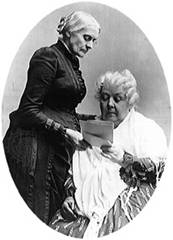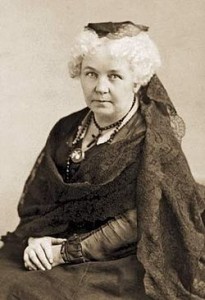Elizabeth Cady Stanton (1815-1902) loved the church, but held it accountable for oppressing women by using the Bible to enforce their subordination. With her good friend Susan B. Anthony (1820-1906), she became one of the most famous women in America. When she published The Women’s Bible, her own translation of the Bible, with commentary on passages offensive to women, a backlash diminished her stature – but prophets always pay a price, and today her views are widely accepted.
Cady Stanton had been struggling with women’s rights for over 50 years when she published The Women’s Bible in 1895. She probably was unaware that she followed a long line of women Biblical exegetes. (Because of the nature of women’s history, with the loss of each generation’s achievements, women of succeeding generations usually could not build on each others’ insights because they were unavailable. However, there is an amazing unanimity among women in history about two biblical passages. In Genesis, women saw that they were created in the image of God, and rehabilitated Eve as God’s masterpiece (not God’s ‘first try’). In the Gospel accounts of the Resurrection, women found Biblical justification for women’s preaching and teaching.
The Women’s Bible was controversial from the first. Unlike the Grimke sisters, who believed that the Bible was wholly on the side of women, Cady Stanton came to believe that women’s subjection was firmly rooted in the Bible. Her Biblical studies led her to conclude that the Bible was written wholly from a male perspective, and was now being used as a political tool by male churchmen. Cady Stanton was shocked at women’s reactions to her work; most women’s groups disclaimed any connection with The Women’s Bible.
Elizabeth Cady Stanton is believed to be the driving force behind the first Women’s Rights Convention in Seneca Falls, New York in 1848. For the next fifty years she played a leadership role in the women’s rights movement. Somewhat overshadowed in popular memory by her long time colleague Susan B. Anthony, Stanton was for many years the architect and author of the movement’s most important strategies and documents. Though she became increasingly estranged from the mainstream of the movement, particularly near the end of her career, she maintained to the end her long time friendship with Anthony.
Stanton had an early introduction to the reform movements, including encounters as a young woman with fugitive slaves at the home of her cousin Gerrit Smith. It was at Smith’s home that she also met her husband Henry Stanton. Soon after their marriage in 1840 they traveled to London, where Henry was a delegate to the World Anti-Slavery Convention. There Elizabeth met Lucretia Mott, the Quaker teacher who served in many of the associated Temperance, Anti-Slavery, and Women’s Rights organizations with which Stanton is associated. Denied her seat at the convention (as were all the women delegates), Mott discussed with Stanton the need for a convention on women’s rights. The plan came to fruition when Mott again met Stanton in the summer of 1848 in the home of fellow Quaker Jane Hunt. Stanton, Mott, and other women leaders created their plan to call the first women’s rights convention, initiating the women’s rights movement in the United States, and Stanton’s role as a leader in that movement. In 1851, Susan B. Anthony was staying at the home of fellow Temperance worker Amelia Bloomer, while attending an anti-slavery meeting in Seneca Falls. Stanton encountered Bloomer and Anthony on the street, and recorded the meeting in her diary as follows:
How well I remember the day! George Thompson and William Lloyd Garrison having announced an anti-slavery meeting in Seneca Falls, Miss Anthony came to attend it… Walking home after the adjournment, we met Mrs. Bloomer and Miss Anthony, on the corner of the street, waiting to greet us. There she stood, with her good earnest face and genial smile, dressed in gray delaine, hat and all the same color, relieved with pale blue ribbons, the perfection of neatness and sobriety. I liked her thoroughly, and why I did not at once invite her home with me to dinner I do not know…
History records the lasting relationship between these two women as well as the strains that resulted from their different roles and priorities. Unwilling to commit to a vigorous travel schedule until her children were grown, Stanton wrote many of her speeches for delivery by Anthony. As the years wore on they held closely together, splitting with many other women over the idea that suffrage for black men after emancipation should take precedence over suffrage for women. Along with Matilda Joslyn Gage, the two led the National Woman Suffrage Association, opposing the concept of “precedence” accepted by the less radical American Woman Suffrage Association.
Later in her career Stanton, like Gage, focused increasingly on social reforms related to women’s concerns besides suffrage. The two worked together on The Women’s Bible, a work rejected by many of the more conservative elements in the movement. They also collaborated with Anthony in writing a history of women’s suffrage. Though Gage split completely with Anthony over Anthony’s successful effort to merge the NWSA with its more conservative counterpart into the National American Woman Suffrage Association, Stanton agreed to serve as president of the combined organization for a brief period. (At the end Stanton took to having her resolutions introduced by others, so fully was her leadership rejected by the newer forces.)
Elizabeth Cady Stanton died in 1902, and like Anthony and Gage, did not live to see women’s suffrage in the United States. She is nonetheless regarded as one of the true major forces in the drive toward equal rights for women in the United States and throughout the world.

The resiliency of the friendship between Stanton and Anthony is illustrated in this photograph, taken at Anthony’s home in Rochester late in their lives.

